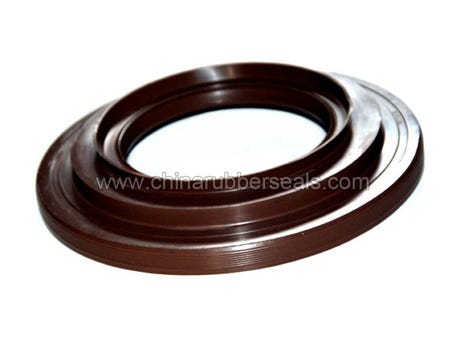We offer quality sealing and cost-effective oil seal designs that help keep equipment running longer while reducing downtime. Through our comprehensive selection we provide oil seals with short lead times and with a variety of designs for use in many common and more challenging industry applications. When selecting an oil seal, it is important to know what sort of design is needed, and we have outlined a few of the more common elements below.
Standard Sealing LIP Designs
Our oil seals have many different available lip designs, with some being simple and others complex, due to their special application. However, the most common industry lip standards are described below:
(single lip): This design uses a garter spring and generally seals against internal media in lower pressure applications. The single lip is not recommended for use in applications in which the environm ent contains dirt or contaminants.
(double lip): This design is also used with a garter spring and consists of a primary lip for sealing against internal media in lower pressure applications. The secondary (also known as the auxiliary lip) provides additional protection from dust and dirt.
(dual or twin lip): This design consists of garter springs and two identical primary lips that are usually used to separate two liquids. The space in between these two lips must be lubricated with grease or something similar.
(single lip): This design has NO spring and is generally used for sealing a non-pressure medium, such as grease or protecting against dirt.
(double lip): This design has NO spring and is generally used for sealing a non-pressure medium, such as grease and is used to protect against dirt as well as internal and external media.

Bluefkm TG Rubber Oil Seal
Standard Sealing CASE Designs
We offer oil seals in many various case designs from the most simple to the most challenging applications. Below are just a few of the most commonly used case designs for most sealing applications:
Type A: Outer metal case with a reinforced plate for structural rigidity. This design is mainly used on shafts when the diameters exceed 150mm, smaller shafts that need extra strength, or when used with special rubber compounds.
Type B: Outer metal case that is mainly used on shafts with diameters under 150mm with bore housing materials made of steel or cast iron. This design provides a firm and accurate seal in the housing; but may limit the static sealing on the outer diameter (O.D.).
Type C: Rubber covered metal case that can be used on any size shaft. The rubber helps prevent the metal from rust & corrosion, and prevents damage during assembly. This design is used in soft alloy, plastic housing materials, and for replacement in environments where there is minor damage to the housing surface.

TB Oil Seal for Shalf Usage
Metal Case Finishes & Treatments
Oil seals with outer metal cases may include finishes or treatments that are applied to the outer edge to aid in rust protection, identification, and sealing of scratches or imperfections in the housing bore. Common finishes applied to the outside edge of metal O.D. oil seals include: Plain (a bonding agent that is usually a yellowish-green color), a Color Painted edge, and a grinded-polished edge.
Oil Seal Style Selection (Common Types)
Combining both the lip and case types explained above, it is easy to assemble the Global O-Ring and Seal (GOR) types as indicated in the following examples:
Type SC: Single lip w/spring, rubber covered O.D.
Type TC: Double lip w/spring, rubber covered O.D.
Type SB: Single lip with spring, metal O.D.
Type TB: Double lip with spring, metal O.D.
Type SA: Single lip w/spring, reinforced metal O.D.
Type TA: Double lip w/spring, reinforced metal O.D.


Comments Please sign in or sign up to post.
0
0 of 500 characters used